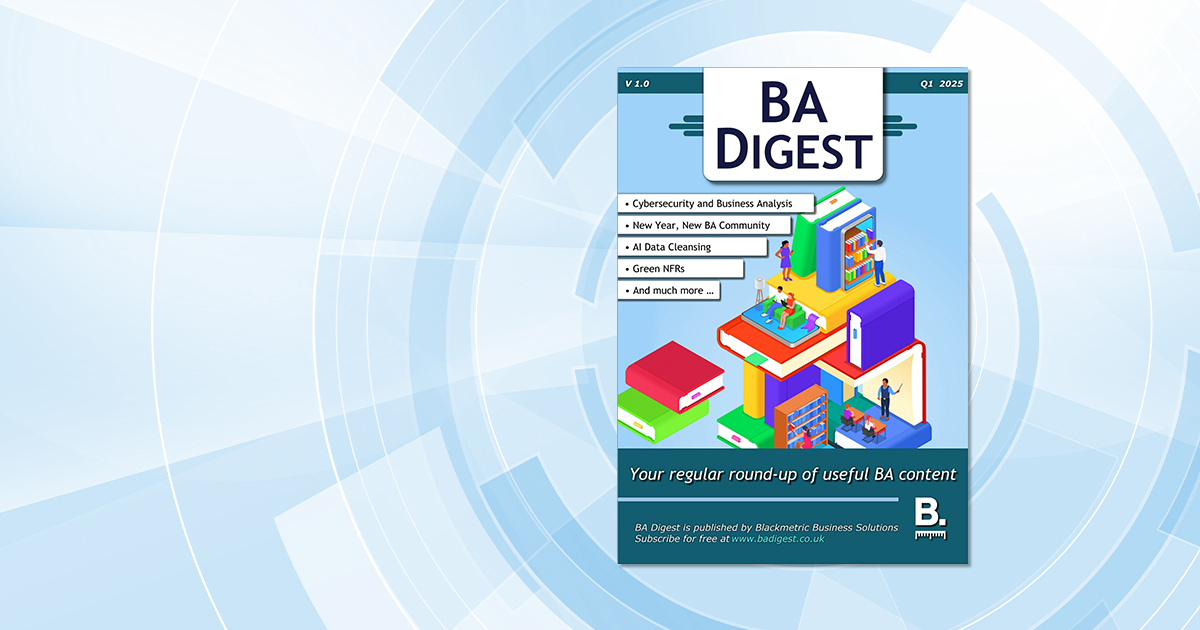Navigating Sustainability, Security, and Silos
3 Key Takeaways from BA Digest (Q1 Edition)
Disclaimer: The views and opinions expressed in this article are those of the author and may not reflect the perspectives of IIBA.
The Q1 edition of BA Digest was recently released, which contains eighteen diverse articles. If you’re short of time, here’s a summary of three.
1. Green NFRs for a Sustainable Future
Colin Cripps, in “Why Software Needs to Adopt Green NFRs to Realise a Sustainable Future,” stresses the importance of incorporating green Non-Functional Requirements (NFRs) to address rising digital carbon emissions. World Economic Forum statistics show that digital emissions, which account for about 4% of global CO2 emissions, are projected to rise significantly in the coming years. Given that our digital activities significantly contribute to this footprint, product teams must consider sustainability in their products and services.
To effectively integrate sustainability into software design, Colin suggests defining specific sustainability NFRs that set carbon emission limits for key software actions. For example, setting a cap on carbon weight per user visit or checkout process allows product teams and developers to explore optimal solutions. This approach reduces emissions and encourages innovation in sustainable practices.
2. Cybersecurity as a Foundational Requirement
In “Business Analysis and Cybersecurity – What Can (or Should) a BA Do?,” Bindu Channaveerappa highlights the role of cybersecurity as a fundamental aspect of business analysis. Cyber incidents often stem from a lack of security awareness and mindset, which calls for business analysis professionals to adapt their roles. Traditionally viewed as an NFR, cybersecurity is now indispensable to thorough analysis.
Bindu introduces a framework to help business analysis professionals integrate cybersecurity considerations into their analysis. It broadens the business analysis toolkit by encouraging practitioners to assess security risks, identify vulnerabilities, and ensure security measures are actionable. It also emphasizes the importance of data security throughout its lifecycle and acknowledges the role of human behaviour in cybersecurity threats. This helps business analysis professionals to develop effective strategies and policies.
Bindu stresses that security is an ongoing journey, not a one-time fix. By embedding cybersecurity into the project development lifecycle from the start, business analysis professionals ensure that security is a priority. They can collaborate closely with IT and security teams to deliver comprehensive analysis that considers both the intended and unintended impacts of business changes.
3. Breaking Down Silos for Effective Change
Mufaro Mary Nyachoto discusses how business analysis professionals can help overcome silos in her article, “Breaking Down Silos – Driving Change as a Business Analyst.” According to A Guide to the Business Analysis Body of Knowledge (BABOK Guide), business analysis professionals facilitate transformation by defining needs and recommending solutions that add value to stakeholders. Yet significant barriers are created when teams operate in isolation, leading to inefficiencies, poor morale, and negative impacts on both employee experience and customer journeys. Mufaro argues that these silos often stem from organizational culture issues including a lack of leadership, trust, and communication.
Mufaro underscores the importance of change leadership and management in driving organizational growth. While change management focuses on the processes involved in restructuring workflows, change leadership is about motivating and inspiring people to embrace these changes. Business analysis professionals can be influential leaders by building relationships and trust across departments. They can also foster collaboration by facilitating workshops, addressing resistance, and ensuring transparency through shared documentation and real-time updates.
By adopting a people-first approach, business analysis professionals help teams understand their purpose and contribution to the organization's long-term goals. This not only aids in achieving strategic objectives but also cultivates a resilient and open culture ready to tackle future challenges.
The Evolving Role of the Business Analysis Professional
These articles collectively highlight the ever-expanding role of the business analysis professional in 2025. As well as more “traditional” analysis work, practitioners continue to push boundaries by:
- Driving sustainability by integrating green NFRs
- Ensuring cybersecurity is a foundational element of every project
- Breaking down organizational silos to foster collaboration and innovation
Continuing to learn and keep pace is essential in a fast-moving world. Be sure to check out IIBA’s KnowledgeHub for more information and inspiration!
For more thought-provoking articles like the ones mentioned above, be sure to download your copy of BA Digest—a free, open-access, quarterly magazine published by Blackmetric that focuses on all things business analysis.
About the Author

Adrian Reed is a true advocate of the analysis profession. He acts as Principal Consultant at Blackmetric Business Solutions, where he provides business analysis consultancy and training solutions to a range of clients in varying industries. He is editor-in-chief of the quarterly open-access magazine BA Digest, and he speaks internationally on topics relating to business analysis and business change. Adrian wrote the 2016 book Be a Great Problem Solver… Now and the 2018 book Business Analyst.



